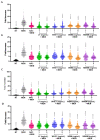Dairy By-Products and Lactoferrin Exert Antioxidant and Antigenotoxic Activity on Intestinal and Hepatic Cells
- PMID: 37238891
- PMCID: PMC10217426
- DOI: 10.3390/foods12102073
Dairy By-Products and Lactoferrin Exert Antioxidant and Antigenotoxic Activity on Intestinal and Hepatic Cells
Abstract
The dairy industry generates a large volume of by-products containing bioactive compounds that may have added value. The aim of this study was to evaluate the antioxidant and antigenotoxic effects of milk-derived products, such as whey, buttermilk, and lactoferrin, in two human cell lines: Caco-2 as an intestinal barrier model and HepG2 as a hepatic cell line. First, the protective effect of dairy samples against the oxidative stress caused by menadione was analyzed. All these dairy fractions significantly reversed the oxidative stress, with the non-washed buttermilk fraction presenting the greatest antioxidant effect for Caco-2 cells and lactoferrin as the best antioxidant for HepG2 cells. At concentrations that did not impact cell viability, we found that the dairy sample with the highest antigenotoxic power against menadione, in both cell lines, was lactoferrin at the lowest concentration. Additionally, dairy by-products maintained their activity in a coculture of Caco-2 and HepG2, mimicking the intestinal-liver axis. This result suggests that the compounds responsible for the antioxidant activity could cross the Caco-2 barrier and reach HepG2 cells on the basal side, exerting their function on them. In conclusion, our results show that dairy by-products have antioxidant and antigenotoxic activities, which would allow revaluing their use in food specialties.
Keywords: Caco-2 cells; DNA damage; HepG2 cells; bioavailability; buttermilk; lactoferrin; oxidative stress; whey.
Conflict of interest statement
There are no known conflicts of interest associated with any of the authors participating in this publication, and there has been no significant financial support for this work that could have influenced its outcome.
Figures




References
-
- Svanborg S., Johansen A.-G., Abrahamsen R.K., Skeie S.B. The composition and functional properties of whey protein concentrates produced from buttermilk are comparable with those of whey protein concentrates produced from skimmed milk. J. Dairy Sci. 2015;98:5829–5840. doi: 10.3168/jds.2014-9039. - DOI - PubMed
-
- Lin K.-L., Wang P.-W., Chuang J.-H., Lin H.-Y., Chen S.-D., Chuang Y.-C., Huang S.-T., Tiao M.-M., Chen J.-B., Huang P.-H., et al. Resveratrol provides neuroprotective effects through modulation of mitochondrial dynamics and ERK1/2 regulated autophagy. Free. Radic. Res. 2018;52:1371–1386. doi: 10.1080/10715762.2018.1489128. - DOI - PubMed
-
- Domingos J.M., Puccio S., Martinez G.A., Amaral N., Reis M.A., Bandini S., Fava F., Bertin L. Cheese whey integrated valorisation: Production, concentration and exploitation of carboxylic acids for the production of polyhydroxyalkanoates by a fed-batch culture. Chem. Eng. J. 2018;336:47–53. doi: 10.1016/j.cej.2017.11.024. - DOI
-
- Eurostat Statistics Explained. 2021. Milk and Milk Product Statistics. [(accessed on 17 February 2023)]. Available online: https://ec.europa.eu/eurostat/statistics-explained/index.php?title=Milk_....
Grants and funding
LinkOut - more resources
Full Text Sources

